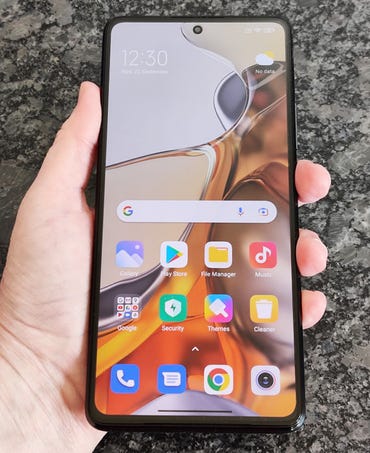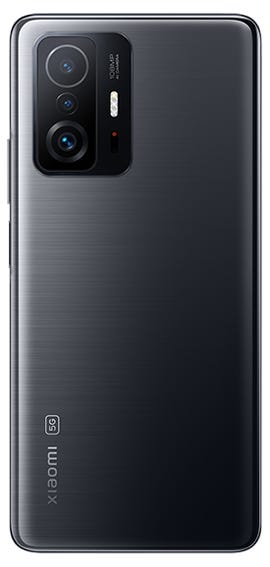Xiaomi 11T Pro review: Lightning-fast charging heads up a good-value specification Review | ZDNet
Xiaomi is known for delivering great value for money, and on the face of it, the Xiaomi 11T Pro should enhance that reputation. For £599, you get a 5G handset, a 6.67-inch 120Hz OLED display and a high-end Snapdragon 888 5G chipset with 8GB of RAM and 128GB of internal storage (256GB bumps the price up to £649). You also get a triple main camera setup that includes the same telemacro lens I liked so much on the Xiaomi Mi 11, a 5000mAh battery and 120W fast charging that claims to get the handset to 100% in just 17 minutes.
The Xiaomi 11T Pro has a strong and sturdy construction, with the display protected by Corning’s top-end Gorilla Glass Victus. Xiaomi is confident enough to provide a free screen repair service for six months after purchase. However, the 11T Pro’s dust and water resistance only runs to IP53 (‘dust protected’, ‘spraying water’). In contrast, flagship-class handsets — including Xiaomi’s Mi 11 Ultra — offer IP68 (‘dust tight’, ‘immersion, 1m or more depth’).
The handset is not distinctive on the screen side. A shallow bezel all around the 6.67-inch display, with a small central camera notch breaking up the screen’s continuity, is unremarkable. Rounded edges lead neatly into the backplate, which is where the Xiaomi 11T Pro differentiates itself.
The 6.67-inch Xiaomi 11T Pro runs on Qualcomm’s top-end Snapdragon 888 5G chipset with 8GB of RAM and 128GB of (non-expandable) storage. The screen is a 120Hz OLED with HDR+ support and 1000 nits peak brightness. There are three rear cameras: 108MP wide, 8MP ultra-wide (120˚) and 5MP telemacro (3-7cm).
Images: Xiaomi
The triple camera array sits in a large lozenge located on the upper left corner of the backplate, where it protrudes significantly, causing the phone to rock and roll around my desk when I jabbed at almost any point on the screen. The back of my Meteorite Grey review unit had a slightly etched design which at some angles reflected the light and looked like brushed metal. The Celestial Blue and Moonlight White versions may not share this feature.
The back of my review unit was a real fingerprint collector, and I was forever giving it a wipe to restore its appearance. Xiaomi provides a clear silicone bumper which removes the fingerprint issue, although it also dissipates the gleam of the backplate and the ability to appreciate that etched pattern.
The bumper has two other key functions. The backplate is very slippery, and the handset frequently fell off my armchair and, indeed, off piles of paperwork on my desk. The bumper is tactile and removes this slip hazard, and also flattens out the camera lozenge protrusion. No more rocking and rolling.
The bumper certainly has its benefits, but it does increase the dimensions and weight of the Xiaomi 11T Pro. Without the bumper, these are 76.9mm wide by 164.1mm deep by 8.8mm thick, and 204g — almost identical to the £499 (128GB)/£549 (256GB) 11T model, which is powered by the MediaTek MT 6893 Dimensity 1200 5G chipset rather than the Snapdragon 888 5G and lacks the Pro’s super-fast charging.

The 6.67-inch OLED screen occupies around 85% of the front of the handset.
Image: Sandra Vogel / ZDNet
Xiaomi doesn’t include a 3.5mm headset jack. The bottom edge houses the SIM caddy, which will accommodate two SIMs, and one of the two speaker grilles — the other is on the top edge. The power button, with an integrated fingerprint scanner, and the volume rocker sit in finger-friendly locations on the right side. Xiaomi likes its IR blasters, and there’s one on the top edge: the provided Mi Remote software allows for remote control of a wide range of devices, including TVs, set-top boxes, projectors, air conditioning units and fans.
The screen is on the large side at 6.67 inches, and one-handed use will be a challenge for many people. On the upside, the screen’s size, its poppy OLED, 2,400-by-1080 pixel resolution (20:9, 395ppi), 120Hz refresh rate, Dolby Vision support, 480Hz touch sampling and maximum 1000 nits of peak brightness make it fantastic for web browsing, text reading and video viewing.
There are four preset colour schemes, the screen can be set to adapt to ambient lighting, and colour temperature can be set to warm, cool or default; you can also set a custom colour temperature. Delve deeper into the advanced settings, and you can opt for DCI-P3 and sRGB colour gamuts or fiddle with RGB, hue, saturation, value, contrast and gamma settings. There’s a lot to play with here, but this isn’t unusual for Xiaomi.
There is a reading mode, but this doesn’t drop the screen into black-and-white; it just mutes the colour tones somewhat and reduces blue light.

Mi Remote (left) lets you control a range of equipment via the top-mounted IR blaster. There’s a range of audio presets available for the dual Harmon Kardon speakers.
Images: Sandra Vogel / ZDNet
The twin speakers deliver pretty good quality sound and to a high volume. Dolby Atmos is switched on by default, and I see no reason to turn it off as it makes for generally better-quality audio and beefs up the bass. There are various graphic equaliser presets, with settings for video, music and voice, along with a dynamic option that will try to work out what you’re listening to for itself, and some specific settings for earphones. There’s a Dolby Atmos toggle in the pull-down quick settings menu, but you must go into Settings to make more granular changes.
My review unit had 256GB of storage, although this £649 model is not yet for sale in the UK. Instead, £599 buys you a Xiaomi 11T Pro with 128GB of storage. Whichever configuration you get, there’s no MicroSD card slot for storage expansion. On my review unit, 23GB was consumed with Android 11, the MIUI 12.5 overlay and a load of add-on software. I’ve already mentioned Mi Remote; there’s also a QR code scanner, a compass, a recorder, a calculator and a wireless sharing app. Third-party apps include the inevitable Amazon, Facebook, TikTok, LinkedIn and eBay, alongside WPS Office and a couple of others. The third-party apps can all be removed if they’re surplus to requirements.
In the Xiaomi 11T Pro, the Snapdragon 888 chipset with 8GB of RAM delivered Geekbench 5 scores score of 697 (single-core) and 3068 (multi-core). The £1,199 Sony Xperia 1 III, based on the same chipset but with 12GB of RAM, turned in scores of 1128 and 3629 respectively, while the more price-comparable Xiaomi Mi 11 (£749) managed scores of 1129 and 3704. It’s unclear why the single-core score is so much lower with the 11T Pro, but I found performance was never a problem in general use.
The 16MP selfie camera has a night mode setting and shoots video at up to 1080p at 60fps. There are three rear-facing cameras: 108MP f/1.75 wide-angle with OIS; 8MP f/2.2 ultra-wide-angle with 120° field of view; and 5MP f/2.4 telemacro with autofocus between 3cm and 7cm.
You can record 8K (7680 x 4320) video at 30fps or 4K (3840 x 2160) at up to 60fps, along with a range of lower resolutions. Good luck finding somewhere to enjoy the 8K video in all its glory. The slow-motion options are also expansive, with 1080p available at 120fps, 240fps and 960fps.
Among the many settings is a dual video mode that shoots from the front and rear cameras at the same time. There’s a lot to play with here, although point-and-shoot photography is very good may satisfy most people. The telemacro camera is a particular joy to use.

Close-up cat, captured by the Xiaomi 11T Pro’s 5MP telemacro camera.
Image: Sandra Vogel / ZDNet
The Xiaomi 11T Pro has a hefty 5,000mAh battery, and this kept the phone going for 16 hours precisely on the PCMark for Android Work 3.0 battery life test. When I asked it to play video for three hours from a full charge, the battery lost just 15% of its charge over that period, suggesting an impressive 20 hours on a linear extrapolation.
Fast charging is not unusual, but Xiaomi’s implementation here is ground-breaking. You’ll need to use the supplied 120W power adapter, which is heavy. If you’re travelling with the handset, it might feel a burden for the bag, but the benefit of fast charging is simply wonderful. The charging speed is due in part to a clever battery design: there are two 2,500mAh batteries instead of a single 5,000mAh unit, which makes it possible to charge both cells simultaneously. As noted earlier, Xiaomi claims its HyperCharge technology will charge the battery to 100% in 17 minutes.
My normal fast-charging test requires 15-minute increments, but here I had to reduce this to 5 minutes in order to measure charging speed. I started the test with the battery at 12%. After five minutes of charging it was at 50%, after 10 minutes it had risen to 73%, and after 15 minutes it was at 95%. Very impressive.

Image: Xiaomi
Conclusions
The Xiaomi 11T Pro is an impressive phone. At the upper end of the mid-range in price, it brings some high-end features along for the ride. Fast charging is undoubtedly the star of the show and may be enough on its own to attract many buyers.
You also get 5G support, a superb 120Hz OLED screen, a flagship-class chipset and a very capable triple rear camera setup. It’s a shame the 256GB version isn’t currently available in the UK, and the ease with which fingerprints smear the back of this phone is annoying.
Still, so long as you don’t need vast amounts of storage and are happy to put your phone in a case or to use the provided bumper, the Xiaomi 11T Pro has a lot going for it.
Recent and related content
Xiaomi Mi 11 Ultra review: Large, powerful and expensive
Xiaomi Mi 11 review: Snapdragon 888 chipset, 120Hz OLED screen, 108MP camera, all at a good price
Xiaomi Redmi Note 10 Pro first take: 108MP camera, 120Hz display, and 5,020 mAh battery
Xiaomi’s rise in the smartphone market sees Q2 revenue soar by 64%
Best cheap phone 2021: Flagship features on a budget
Read more reviews
For all the latest Technology News Click Here
For the latest news and updates, follow us on Google News.
